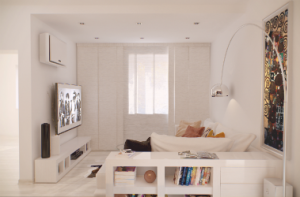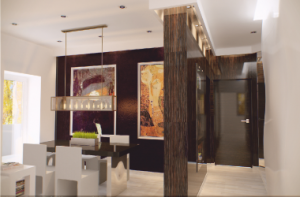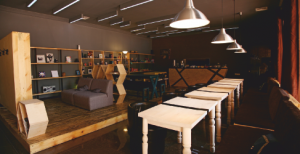Zafara Alieva,
Art Critic
Products of design can now be found everywhere, ranging as they say, from a needle to an airplane. And although the history of design counts more than a hundred years, it is a principally new creative area. As a cultural phenomenon, design evolution represents a change that is rather essential than superficial: every change stands for modifications in industry, science, aesthetics and society.
 People have been creating the objective world for many centuries, producing, so to say, spontaneous design that differed from the professional one primarily in the absence of a special study and modelling of an object’s functionality. In the 20th century, object design developed in parallel to new areas of science and technology. For instance, in the 1950s Arthur Drexler suggested that the designer should to know as much as possible about the consumer. Market research became the content of a new science – marketing, and the result of designers’ collaboration with psychologists and sociologists. Another contribution designers made was ergonomics or engineering psychology – a science that helps adapt articles to humans. It was based on anthropometric standards proposed by Henry Dreyfus in the early 1960s, showing the human body in different positions with the use of X-ray images.
People have been creating the objective world for many centuries, producing, so to say, spontaneous design that differed from the professional one primarily in the absence of a special study and modelling of an object’s functionality. In the 20th century, object design developed in parallel to new areas of science and technology. For instance, in the 1950s Arthur Drexler suggested that the designer should to know as much as possible about the consumer. Market research became the content of a new science – marketing, and the result of designers’ collaboration with psychologists and sociologists. Another contribution designers made was ergonomics or engineering psychology – a science that helps adapt articles to humans. It was based on anthropometric standards proposed by Henry Dreyfus in the early 1960s, showing the human body in different positions with the use of X-ray images.
The key problem in the theoretical design conceptualization remains the question of the nature of design activity and its relation to other art forms. Obviously, designers working on the consumer goods shape employ artistic means of morphogenesis. Their work can be compared to that of engineers and developers inventing new materials and structures that influence the object appearance. Design often relates to architecture, and for this reason is also referred to as ‘architecture of small form’. It is compared with decorative art, which is basically not entirely correct, yet it reflects a design easel-ization trend when concept development runs ahead of implementation, or with applied arts (crafts), and that, on the contrary, is justified, when it comes to a singular design.
The recent years have seen a crisis of the “international style”, with its ‘form follows function’ motto as a criterion of “true design” actually not working. It turned out that delivering on this motto in a situation of highly developed industry inevitably results in a personality-deprived environment. The lessons learned form this “style” demonstrate that design can be the source of environmental tension and even alienation if it created an environment relying exclusively on the functional needs, leaving out the images belonging to spiritual and artistic culture. Therefore, the design industry has developed a ‘culturological’ approach that considers design a legitimate product of human culture development. Technology encroaching on nature and cultural values, along with the “international style” crisis, provoked an interest in the material world as a reflection of traditions and in its ethnic and cultural distinctiveness. Perhaps this is the way to humanize the object-space environment and to give it some meaning.
Interest in ethnic traditions is not an anachronism or a mere fascination with folklore, but a process of opposing the “international style”. Now the common practice worldwide is to invite foreign designers to the country to do the job and train local experts. Especially popular are specialists from the countries with advanced design industry and particularly strong material culture traditions. These are Japan, Italy, and Finland.
 Nowadays two global processes get into focus: quick scientific and technological progress, and social and environmental problems it causes. The world of technology gets increasingly autonomous; new manufacturing and design tools that appeared in the age of computer technology, as well as new materials facilitate the self-organizing techno-world. The “second nature” threatens to become the only one, as indicated by the intensifying process of the physical displacement of the natural world. The expansion of new technologies in the culture and lifestyle domains is conductive to fundamental social and cultural transformations.
Nowadays two global processes get into focus: quick scientific and technological progress, and social and environmental problems it causes. The world of technology gets increasingly autonomous; new manufacturing and design tools that appeared in the age of computer technology, as well as new materials facilitate the self-organizing techno-world. The “second nature” threatens to become the only one, as indicated by the intensifying process of the physical displacement of the natural world. The expansion of new technologies in the culture and lifestyle domains is conductive to fundamental social and cultural transformations.
An ecological approach to design in the 1970s was a response to the revolutionary developments in science and technology. Although ecological criteria have always been taken into account in human activity, this time they get deliberately emphasized. The basic principles of eco-aesthetics are already worked out: design products should have a positive effect on human psyche, stimulating creativity and eco-awareness. Critics, however, argue that these principles may result in the aesthetics of “new Puritanism” as modesty is also interpreted as a call to asceticism. On the other hand, “new Ornamentalism” is also predicted as a way of compensating material experience with aesthetic one. Eco-design is refuted as a phenomenon that masks and aggravates social woes, or is considered excessively naive. Yet it has already been recognized by many as an effective means of bringing greater harmony into society.
In turn, ecological principles in design mainstreamed the question of importance of the natural factor in the objective environment and accentuated the impact of climate on the way of life in a particular climatic environment. Ecology can certainly not be limited to the biological environment conservation, which explains the keen interest of eco-design in regional and historical experience. Cultural environment is not less important for the person’s morality, self-discipline and social identity. Apparently, both approaches to the current issues in design – the ecological and cultural identity – are interrelated and can be seen as pertaining to the domain of cultural ecology.
Thus, Authentic became one of the currents in contemporary object and interior design. One good example is the first traditional cuisine restaurant and art gallery “Caravan” (Tashkent, 2001) – one of the projects implemented in Uzbekistan by designer artist Babur Ismailov. Very soon the site became almost a benchmark for similar projects across the country. Sources of inspiration: traditional Uzbek adobe house, ceilings with open beam frame, built-in niches for house utensils, carved pillars and doors, straw mats, embroidered wall-rugs, floor tiles and facing majolica, antiques, and fusion style technique. Interior ornamentation materials: wood, textile, adobe (saman), ceramics. Key form: handmade organic. Philosophy: cultural ecology and non-conformism.
 Another example of authentic workmanship in the context of traditional techniques is joint international art projects: Bobur Ismailov as lead author collaborated with the renowned Japanese architect Kozo Iwateni consulting on Japanese aesthetics to work on the Japanese food restaurant “Izumi” (Tashkent, 2007). Their co-author was Valeria Barsukova working on object design. Sources of inspiration: traditional Japanese house and stone garden (wood, water spring, rounded stones), also sliding partitions, straw mats, screens, tea tables, etc. Interior materials: wood, ceramics. Key form: geometry (square, circle). Philosophy: Zen Buddhism.
Another example of authentic workmanship in the context of traditional techniques is joint international art projects: Bobur Ismailov as lead author collaborated with the renowned Japanese architect Kozo Iwateni consulting on Japanese aesthetics to work on the Japanese food restaurant “Izumi” (Tashkent, 2007). Their co-author was Valeria Barsukova working on object design. Sources of inspiration: traditional Japanese house and stone garden (wood, water spring, rounded stones), also sliding partitions, straw mats, screens, tea tables, etc. Interior materials: wood, ceramics. Key form: geometry (square, circle). Philosophy: Zen Buddhism.
Great potential for the development of Authentic is harboured in the objective world and interior setup of a Karakalpak yurt. A yurt is essentially the most ancient form of dwelling that accumulates the many-century experience of the eastern nomads who invented this mobile transformer frame. The Karakalpak people associated the yurt with a cosmogony idea of a binary division of the universe, which was reflected in the interior zoning, lighting and air exchange solutions. They used uniform “furniture” such as chest, stand, hanging canvas bags, etc. Every object served a functional purpose and was given an artful form within a laconic and yet life-affirming aesthetics of a “functional beauty”.
It was not so long ago when people were making up for the memory of a total deficit in the former unitary state by ornamenting their homes and buying things for a stock. Over the years of independence the country made its market saturated with goods, and though the momentum still exists to fill up homes with chaotic “nice” and non-functional items, the overloaded interiors no longer amaze, while an original idea gets increasingly appreciated. Satiation with luxury and a new awareness of the masses characterize a stable economy where man realizes his self-sufficiency. This kind of trend is relevant in big cities where home is understood not so much as a fort or a “castle”, but as a ‘territory of peace and tranquillity away from the everyday hustle and bustle’. The best ideas come when it is quiet, and the credit for that can be taken by designers upholding their professional and creative stance.
Popular in modern-day design is the so-called fusion style that combines the non-combinable, taking in completely different ideas from the previously incompatible styles, yet without loosing integrity and harmony. Unlike the eclectic, fusion can mix very different styles, combine ethnic and classical elements. Its key criterion is a sense of measure and professional improvisation. In Uzbekistan, fusion style is used not only in private interiors, but also in public places, such as hotels, restaurants, boutiques…
Local designers often create interiors in the Contemporary style that is different from the detail-rich historical stylizations and provocative ultra-modern trends. It is also known as the style of common sense; its main features are functionality, comfort and spaciousness. A Contemporary style interior gravitates toward large straight or softly curving lines, neutral elements, and few accessories. It extensively uses metal, glass, synthetic materials and engineered stone, which lend the interior its ultimate modern look. Lighting, often concealed (highlighted niches, walls or individual objects), shape the space. The style priority: bounty should not be ostentatious. There is no pretentiousness in it, while every object is of the finest quality. Textiles with geometric designs and objects of certain artistic value are intended to dilute the sterile “aesthetics of emptiness”. The growing popularity of the Contemporary style comes from the fact that it mitigates or eliminates the downsides of other styles. It integrates ultramodern trends and traditions of the recent past.
Having grown from the constructivism of the 1920s and absorbed the urban trends of the second half of the 20th century (minimalism, hi-tech, loft), Urbanism today embodies all the very best that urban environment can offer. The fruit of modern-day aesthetics, urban style is only applicable to an urban home, being inspired by the realities of big city life. The style is based on space with plenty of light, air, and space itself (as spaciousness) and void (as freedom). These interiors are laconic, with meagre means of expression in a monochrome palette. Ornamentation employs object design inventions, as well as black-and-white photographs and rare posters. Ordinary case furniture is a no-no: everything is built-in. Architectural structures and shapes, along with colour minimalism define the style. “Urban” materials (bare brick, concrete, glass, stone, metal, polymers) are complemented by wood, ceramics, textiles, and Venetian plaster. Architectural features: steps, pylons, raised levels (podiums, mezzanine floors), niches, drop ceiling elements, lighting brackets. Of great importance is the high quality of materials, which substitutes the almost complete absence of ornamentation: furniture itself becomes an ornament.
Urban style is preferred by the well-known designer Valeria Barsukova (Tashkent): “I am thrilled by the Urban anti-logic: never repeated elements, playing with unpredictable space, curved wall lines, openwork and mirror partitions, glass doors and walls. Relevant are the fusion techniques of merging different twentieth century styles and combining natural and synthetic materials, as well as the inside-outside connection that is made possible in the modern-day architecture, when the inside continues on the outside and the vice versa…”
Radical Urbanism in interior design is rarely found in residential quarters, while being popular in offices and public buildings. Urban style has many faces, ranging from a democratic “eco” to costly “technotron”, but it is always ultra-modern. The style is explored by Valeria Barsukova and Ulugbek Holmuradov.
“I gravitate to a hardcore non-profit design that can be serious and funny at the same time. I prefer combining archaic and modern, different textures and materials, and I call it thus – a policy of crude contrasts: concrete plus wood, cold and warm colours, and so on. I often use wood and brick, being generally fond of natural materials. I would like to realize some design ideas for the furniture made of high-tech polymers. Of the colours my preference is for dark shades: from greyish-brown to black; and there should be a couple of bright contrasting ones. However, what is good in architecture may not always be suitable for object design; everything is relative. The criterion is to go beyond stereotypes”, Holmuradov says. His Anti-Cafe project (2014), the first one of this kind in Uzbekistan, presents a democratic urban style. Sources of inspiration and materials: loft art studio, Scandinavian home furniture, painted walls, plank floors, metal lamps, through shelves, tables and chairs of blond woods with an untreated surface, city explications. Key form: geometry. Philosophy: ecological principles, functionality, non-conformism.
Presently, the object and interior design in Uzbekistan explores a variety of trends and styles. In this new creative area for the country one can see some currents that are definitely driven by market demand. However, local designers have been able to define their professional positions, and it would be safe to say that they do influence the consumer’s aesthetic taste. Among them are the leading interior and object designers Ulugbek Holmuradov and Valeria Barsukova, the renowned designer artists Bobur Ismailov, Jahongir Yakubov, Zaur Mansurov, and others.
As everywhere in the world, design in Uzbekistan in the 21st century claims a two-pronged title of the art and the fruit of a high technology science. Growing demand ensures the development of design as an independent domain, which every man gets exposed to in his daily life. The viability of design has already made it possible to organize an integrated objective environment, and its attainments are unquestionable. However, the theoretical fundamentals of design have not been worked out yet, and the boundaries of design-related activity are not defined either. This suggests that design is still evolving.
References
1. Полевой В. М. Двадцатый век. М.,1989.
2. Гуманитарно-художественные проблемы образа жизни и предметной среды // Труды ВНИИТЭ. Сер. «Техническая эстетика»: Вып. 58. М., 1989.
3. Дизайн США / Ред. Б. Хорриган. Манила, 1989.
4. Кантор К. М. Правда о дизайне. М., 1996.
5. Ковешникова Н. А. Дизайн: история и теория. М., 2013.
